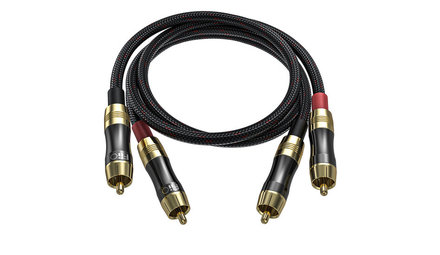

- 6500+ reviews score 9.4 average
- Free shipments over 30 euro in The Netherlands and Belgium
- Free returns within The Netherlands and Belgium
- Shipment in the EU
AudioQuest Black Lab
SOLID LONG-GRAIN COPPER (LGC) CONDUCTORS: Solid conductors eliminate strand-interaction distortion. Black Lab’s solid Long-Grain Copper allows a smoother and clearer sound than cables using regular OFHC (Oxygen-Free High-Conductivity) copper. OFHC is a general metal industry specification regarding “loss” without any concern for distortion. LGC has fewer oxides within the conducting material, less impurities, less grain boundaries, and definitively better performance.
FOAMED-POLYETHYLENE INSULATION: Any solid material adjacent to a conductor is actually part of an imperfect circuit. Wire insulation and circuit board materials all absorb energy (loss). Some of this energy is stored and then released as distortion. Black Lab uses air-filled Foamed-Polyethylene Insulation on both conductors because air absorbs next to no energy and Polyethylene is low-loss and has a benign distortion profile. Thanks to all the air in Foamed-PE, it causes much less of the out-of-focus effect common to other materials.
METAL-LAYER NOISE-DISSIPATION SYSTEM (NDS): 100% shield coverage is easy. Preventing captured RF Interference from modulating the equipment’s ground reference requires AQ’s Noise-Dissipation System. Noise-Dissipation System prevents a significant amount of RFI from reaching the equipment’s ground plane.
SYMMETRICAL COAX GEOMETRY: Identical + and – conductors prevent the shield being used as an inferior audio conductor.
COLD-WELDED GOLD-PLATED PLUGS: This plug design allows for a connection devoid of solder, which is a common source of distortion. Because the ground shells are stamped instead of machined, the metal can be chosen for low distortion instead of machinability.
GROUNDING: Sometimes there is a hum problem unless the subwoofer and AV receiver (or surround-sound processor) are attached to each other using a separate wire. If your system has a hum problem, try attaching the little spade-lug tails to the metal chassis of the subwoofer amplifier and to the chassis of the sending component. Usually, this extra wire will not be needed.
- Homepage
- Specials
- Streaming Audio
- Headphones
- Sound
- Vision
- Network
- Storage
- Smart Home
- Cables & Accessories
- Top 10
My account
New customer?
- Create an account to check your orders
- Make your shop experience better and faster
- Save your cart and save products to your wishlist




